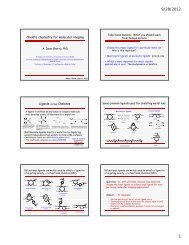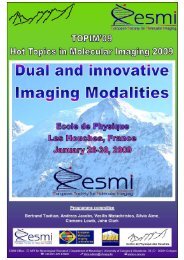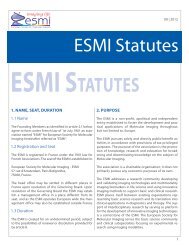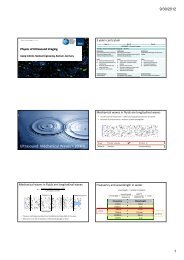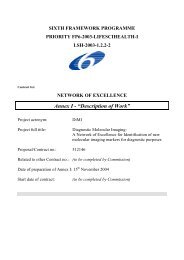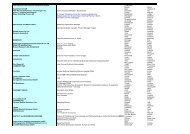5th EuropEan MolEcular IMagIng MEEtIng - ESMI
5th EuropEan MolEcular IMagIng MEEtIng - ESMI
5th EuropEan MolEcular IMagIng MEEtIng - ESMI
Create successful ePaper yourself
Turn your PDF publications into a flip-book with our unique Google optimized e-Paper software.
<strong>5th</strong> <strong>EuropEan</strong> <strong>MolEcular</strong> <strong>IMagIng</strong> <strong>MEEtIng</strong> – EMIM2010<br />
Preclinical imaging of the type 1 cannabinoid receptor in neurodegenerative diseases<br />
Casteels C. (1) , Van Laere K. (1) .<br />
University Leuven, Division of Nuclear Medicine, Belgium<br />
cindy.casteels@med.kuleuven.be<br />
The endocannabinoid system (ECS) is an important<br />
modulatory system in the brain. It consists of a family<br />
of naturally occurring lipids, the endocannabinoids,<br />
of transport and degradation proteins, and of<br />
cannabinoid receptors. Type 1 cannabinoid (CB1)<br />
receptors are abundantly expressed in all brain areas,<br />
especially those involved in the control of motor<br />
function. CB1 receptor stimulation modulates<br />
GABA, glutamate and dopamine neurotransmitter<br />
release in a dynamic activity manner.1<br />
Dysregulation of cannabinoid-mediated control<br />
of basal ganglia function have been suggested to<br />
play a critical role in the pathogenesis and symptom<br />
development of Parkinson’s disease (PD) and<br />
Huntington’s disease (HD), providing rationale for<br />
potential ECS-targeted therapy in these diseases.2<br />
However, at present, limited clinical pilot trials have<br />
been inconclusive. As only in vitro, ex vivo and<br />
post mortem data on the ECS existed until recently,<br />
functional in vivo imaging may play an important<br />
role in the further evaluation of the neurobiological<br />
and clinical impact of the ECS in PD and HD.<br />
Here, we present the in vivo characterization of CB1<br />
receptor alterations in preclinical models of PD and<br />
HD using PET and [18F]MK-94703. Both genetic<br />
and toxin-based experimental models will be presented.<br />
Their relevance to mimic the human condition<br />
will be discussed as well.<br />
Acknowledgement: Financial support of the Research<br />
Council of the Katholieke Universiteit Leuven<br />
(OT/05/58), the Fund for Scientific Research,<br />
Flanders, Belgium (FWO/G.0548.06), and the Institute<br />
for the Promotion of Innovation by Science and<br />
Technology in Flanders (SBO50151) is gratefully<br />
acknowledged. This work is performed under European<br />
Commission FP6-project DiMI,LSHB-CT-<br />
2005-512146<br />
References:<br />
1. Katona et al., Nat. Med. 2008;<br />
2. Maccarrone et al., Prog. Neurobiol. 2007;<br />
3. Burns et al., Proc. Natl. Acad. Sci. U.S.A. 2007.<br />
<strong>EuropEan</strong> SocIEty for <strong>MolEcular</strong> <strong>IMagIng</strong> – <strong>ESMI</strong><br />
YIA applicant<br />
day1<br />
Parallel Session 2: NEUROSCIENCE I



